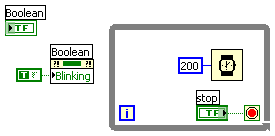- Subscribe to RSS Feed
- Mark Topic as New
- Mark Topic as Read
- Float this Topic for Current User
- Bookmark
- Subscribe
- Mute
- Printer Friendly Page
Controlling relay board via printer cable
08-01-2008 10:19 AM
- Mark as New
- Bookmark
- Subscribe
- Mute
- Subscribe to RSS Feed
- Permalink
- Report to a Moderator
Please bear with me as I am an absolute beginner with LabVIEW, but want to learn.
My boss has asked me to try and write a program to control a PC relay driver board, which is here: http://www.quasarelectronics.com/3074.htm
According to the user manual "you can write your own programs in any language to output a byte to the printer port and the bits which are high will turn on the corresponding relay. The overlay on the PCB shows which bit in the output byte turns that particular relay on. For example, output 00010001, or 11 in hex turns on relays 1 & 5. Each relay number is also marked on the overlay for easy reference." Do I need a printer driver, do I need a DLL?
Could anybody show me where I should start, or lead me through some way? To me the problem sounds like it might be relatively easy, but too much for me
any help would be greatly appreciated
thanks,
Gwilym
08-01-2008 10:37 AM
- Mark as New
- Bookmark
- Subscribe
- Mute
- Subscribe to RSS Feed
- Permalink
- Report to a Moderator
This is quite easy actually. I've done this type of relay control in the past... works well..
Do I need a printer driver, do I need a DLL?
No. All you need is your PC and the Labview Development System. You may have to change some settings in the PC's BIOS. I'll look for the post I wrote on this.
Could anybody show me where I should start, or lead me through some way?
Yes. Open LabVIEW
Under the Help menu, select >Find Examples
Do a search on "Parallel Port" There are two examples that will be useful. You will need to set the addres of your port, which you can find in the Control Panel > System > Hardware Tab > Device Manager
Look under COM & LPT Port, and open the properties for the LPT port. The resource address should be there. Mine is : 0378
Follow the instructions in the example. You can experiment a little and wtach how it controls the relays.
In the meantime, I will look for the thread & a document that discusses this subject.
R
08-01-2008 10:40 AM - edited 08-01-2008 10:41 AM
- Mark as New
- Bookmark
- Subscribe
- Mute
- Subscribe to RSS Feed
- Permalink
- Report to a Moderator
Have a look at this thread.
And this post.
which has a .pdf document called: General Information on Parallel Ports.pdf
Let me know how it goes.
R
Message Edited by JoeLabView on 08-01-2008 11:41 AM
08-01-2008 11:27 AM
- Mark as New
- Bookmark
- Subscribe
- Mute
- Subscribe to RSS Feed
- Permalink
- Report to a Moderator
thanks for such a quick response!
08-06-2008 09:58 AM - edited 08-06-2008 10:00 AM
- Mark as New
- Bookmark
- Subscribe
- Mute
- Subscribe to RSS Feed
- Permalink
- Report to a Moderator
I'm using a modified version of the "parallel read and write" example and am trying to send to the out port for a user selected number of cycles, then go on to send a different set of signals to the port.
I thought that I could use a For Loop to control how many times, and then put a Sequence Structure around all of that to cover what happens after the For Loop has run its course.
Eventually I'm aiming towards having a button that allows the user to just insert or put on the end another frame in said Sequence Structure should they wish to have more sets of cycles.
Could anybody put me right in my misunderstanding and put me back on track (again)?
thanks in advance!
Gwil
p.s. Our lab only has LabVIEW 7.1, is this a problem?
Message Edited by gwilbob on 08-06-2008 10:00 AM
08-06-2008 10:30 AM
- Mark as New
- Bookmark
- Subscribe
- Mute
- Subscribe to RSS Feed
- Permalink
- Report to a Moderator
Auto-indexing and shift registers are explained in the LabVIEW Help and in the tutorials.
I didn't completely understand what you were describing with sequence frames and buttons.
08-06-2008 11:52 AM
- Mark as New
- Bookmark
- Subscribe
- Mute
- Subscribe to RSS Feed
- Permalink
- Report to a Moderator
08-08-2008 08:18 AM
- Mark as New
- Bookmark
- Subscribe
- Mute
- Subscribe to RSS Feed
- Permalink
- Report to a Moderator
Is there a simple way of doing this that I've missed?
I've tried to do it by using two different For loops and local variables, but the local variable only gets sent and the beginning and end of the looping.
Sorry about this continued pestering, but I do seem to be getting somewhere, even if it doesn't look like it externally...
thanks!
08-08-2008 09:34 AM - edited 08-08-2008 09:35 AM
- Mark as New
- Bookmark
- Subscribe
- Mute
- Subscribe to RSS Feed
- Permalink
- Report to a Moderator
If you want to use a different blinking rate use a shift register in a loop:
Message Edited by smercurio_fc on 08-08-2008 09:35 AM
08-08-2008 09:54 AM
- Mark as New
- Bookmark
- Subscribe
- Mute
- Subscribe to RSS Feed
- Permalink
- Report to a Moderator
Either way, the blinking is not the important bit, it's just a test output.
Doing something for a period of time, then doing something else is what I can't get a hold of. Can you help with that one?
thanks again!
Gwilym


